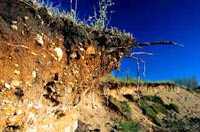|
|
|
|
|
|
|
Quiz Format History of Agriculture Quiz Livestock Quiz Crop Quiz Food Quiz |

|
|
|
|
|
1. Soil organisms, like bacteria and fungi, have their greatest effect in the soil ***. a. as decomposers of dead organic matter
2.Harmful organisms and pollutants from ground water *** .
a. pollute the soil for decades
3. Soil pH that is high in free hydrogen ions ***.
a. may be found around sloughs in the southwest portion of the province
4. "Parent material" may be found in the ***within soil profile.
a. topsoil layer
5. Cryosolic soil would most likely be found ***.
a. in the Swift Current area
6. Darkness of soil types is usually determined by the presence of *** in the soil.
a. parent material
7. Removal of *** in a crop can be attributed to cultivation of a soil. This element must be replaced by fertilizers.
a. phosphorus
8. Strip cropping, planting shelterbelts and fertilization of soil may help to reduce the problem of ***.
a. soil salinity
9. A special kind of fungus called Mycorrhizae invades plant root cells and aid in transfer of soil nutrients and water into the plant. This fungus is classified as a ***.
a. macroorganism
10. The process of soil formation in which large mineral particles are converted into smaller particles without changing the identifying properties, is called ***.
a. soil leaching
|
|
|
|
